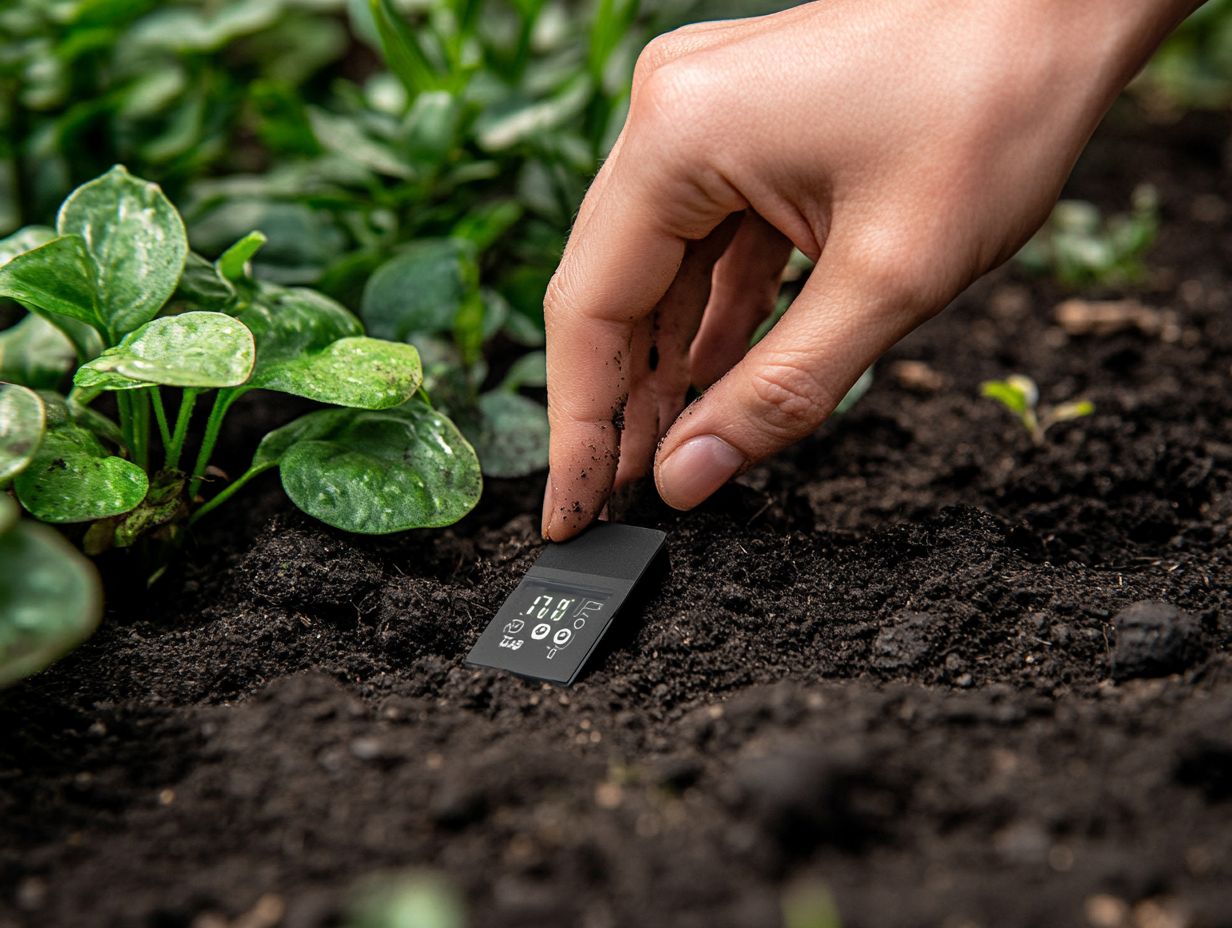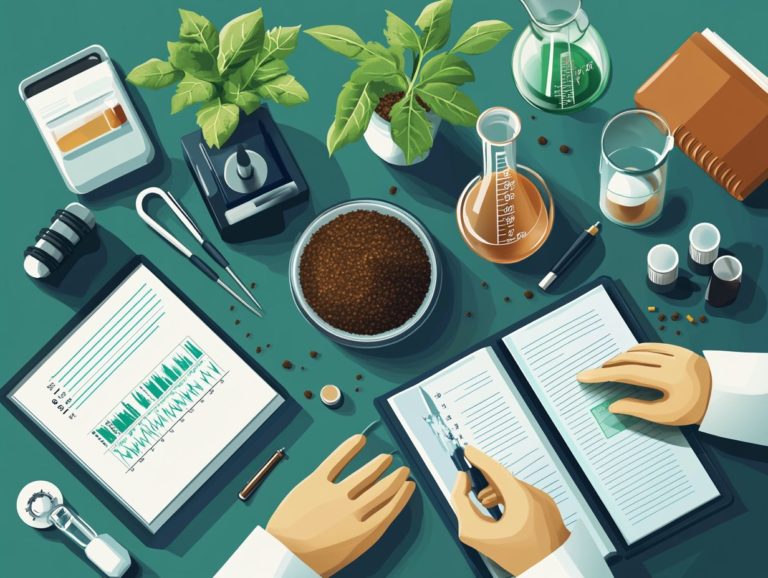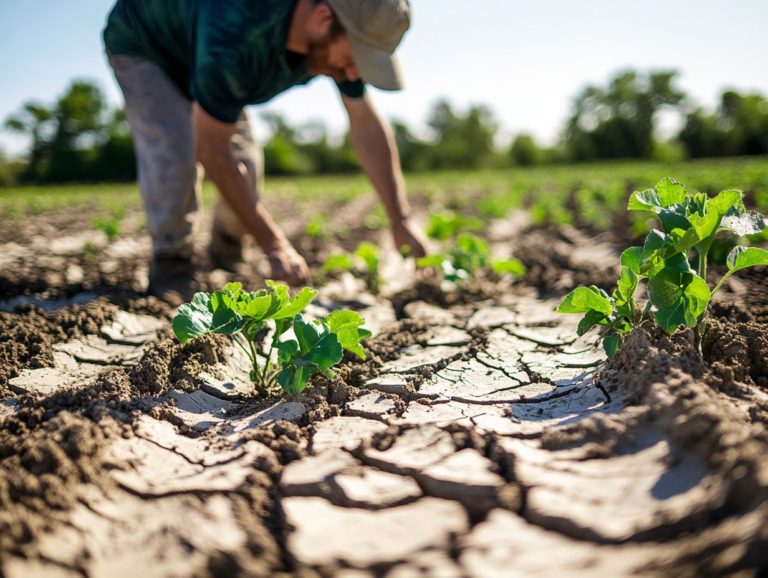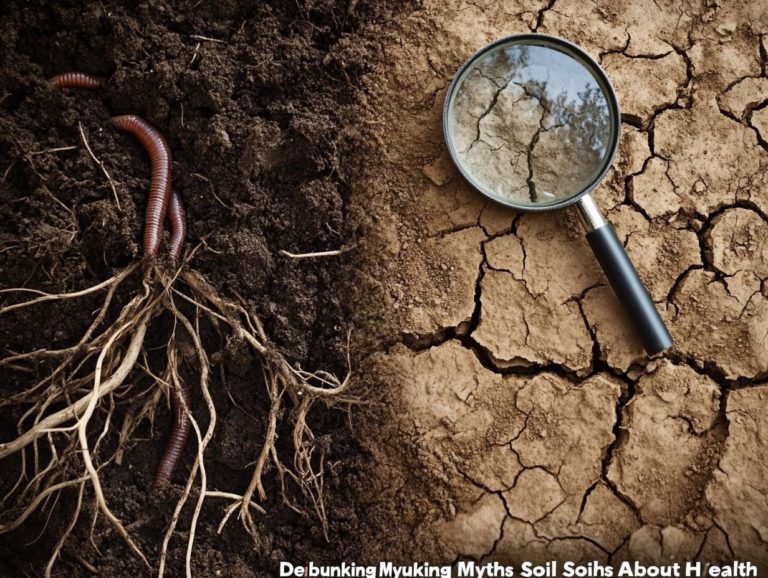How to Monitor Soil Moisture Levels
Understanding soil moisture levels is essential for nurturing healthy plants and optimizing growth. Monitoring moisture in the soil directly influences plant vitality.
This article delves into the importance of keeping track of soil moisture. You’ll find a discussion on various techniques for measuring it, alongside an analysis of their advantages and drawbacks.
We also examine the factors that affect moisture levels, such as climate and soil type. You’ll gain insights into interpreting moisture readings and effective tools for monitoring them, along with best practices for maintaining optimal moisture levels.
Whether you re a seasoned gardener or just starting out, this guide will equip you with the knowledge you need to support your plants health and enhance your agricultural monitoring efforts.
Contents
- Key Takeaways:
- The Importance of Monitoring Soil Moisture Levels
- Methods for Measuring Soil Moisture
- Factors Affecting Soil Moisture
- Interpreting Soil Moisture Readings
- Tools for Monitoring Soil Moisture
- Types of Sensors and Equipment Available
- Tips for Maintaining Optimal Soil Moisture
- Best Practices for Watering and Irrigation
- Frequently Asked Questions
- 1. How do I monitor soil moisture levels?
- 2. What is the best time of day to monitor soil moisture levels?
- 3. Can I use a moisture meter for all types of soil?
- 4. How often should I monitor soil moisture levels?
- 5. Can I use a smartphone app to monitor soil moisture levels?
- 6. Is it necessary to monitor soil moisture levels?
Key Takeaways:

- Monitoring soil moisture levels is crucial for healthy plant growth and development.
- Various methods for measuring soil moisture have their own advantages and disadvantages.
- Understanding the factors that affect soil moisture, such as climate and soil type, can help interpret readings and maintain optimal levels for plants while considering environmental impact.
The Importance of Monitoring Soil Moisture Levels
Monitoring soil moisture levels is essential for your agricultural success. It directly influences plant growth, irrigation management, and the overall effectiveness of your agricultural strategies.
By grasping the nuances of soil moisture, you can make informed decisions about water supply, especially in the face of shifting climate conditions and the rising frequency of agricultural droughts.
Embracing technologies like remote sensing and satellite technology can be a game-changer for you. These tools enable accurate assessments of soil characteristics and enhance your water management strategies.
This precision boosts your irrigation practices and crop yields, ultimately contributing to sustainable agriculture.
Impact on Plant Growth and Health
Soil moisture plays a pivotal role in influencing your plants’ growth and health. It determines the availability of water and essential nutrients crucial for optimal development, including key aspects of soil chemistry.
When moisture content dips too low, plants face water stress, leading to stunted growth and diminished yields. This stress disrupts the balance in the root zone, where soil water potential is vital for maintaining cellular functions.
On the flip side, maintaining adequate moisture levels enhances the health of the root system, supporting essential processes like nutrient uptake.
Different plant species have specific moisture needs. For instance, many drought-resistant varieties flourish with less water, while others, like rice, require consistently saturated conditions.
The presence of organic matter significantly boosts the soil’s ability to retain water, creating a rich environment that nurtures your plants effectively.
Methods for Measuring Soil Moisture
You have a variety of methods at your disposal for measuring soil moisture, each offering its own advantages. From traditional gravimetric techniques that provide fundamental insights to cutting-edge soil moisture sensors, the options are plentiful.
Advanced technologies such as Time Domain Reflectometry, a technique using radio waves to measure moisture levels, and tensiometers play a crucial role in moisture measurement.
These technologies enhance your ability to accurately assess moisture levels, ensuring you choose the best approach for your specific needs.
Don t wait! Start monitoring your soil moisture today and watch your plants thrive!
Pros and Cons of Different Techniques
Measuring soil moisture has unique advantages and disadvantages. Knowing methods like soil moisture sensors and tensiometers helps you make informed decisions that meet your needs.
Compared to traditional methods, such as gravimetric measurement, modern technologies are quicker and less labor-intensive. These tools offer quicker insights and enhanced accuracy.
Soil moisture sensors provide real-time data and are easy to install. Tensiometers measure water tension in the soil, both offering cost-effective solutions that can boost irrigation management.
Factors Affecting Soil Moisture

Several factors influence soil moisture levels, including climate, soil type, texture, and organic matter. Each element plays a crucial role in shaping the water retention capabilities of the soil.
Understanding these factors can boost your land management efforts and increase soil water potential!
Climate, Soil Type, and Plant Species
Climate changes, soil type, and specific plant species significantly impact moisture retention, influencing agricultural productivity and water management strategies.
Understanding how climate conditions and soil variability interact is essential for effective farming. For example, sandy soils drain quickly, leading to moisture loss, while clay soils retain water but may struggle with aeration.
Selecting plant species suited to these conditions enhances your water efficiency. Drought-resistant varieties thrive even in challenging moisture situations, enabling sustainable crop production.
This strategic choice improves your water management and boosts your overall yields! Your farming efforts will become more rewarding.
Interpreting Soil Moisture Readings
Interpreting soil moisture readings is crucial for understanding optimal moisture levels for your plants. This knowledge helps maintain proper water balance and prevents issues related to water stress and deficits.
Understanding Optimal Levels for Plants
Determining optimal moisture levels for your plants requires a keen understanding of their unique needs. Soil water content and soil texture influence their growth and overall health.
Different species show remarkable variations in moisture tolerance. Some thrive in consistently damp environments, while others prefer the arid side of life. This variance highlights the value of using soil moisture maps, which visually represent moisture availability in your garden.
These tools can help tailor your irrigation practices to meet the specific needs of your diverse plant types. Regularly check the soil moisture content with a hygrometer. Implementing a drip irrigation system can deliver water directly to the roots, reducing waste and fostering healthier plant development!
Tools for Monitoring Soil Moisture
You have access to a diverse array of tools for monitoring soil moisture, from sophisticated sensors to cutting-edge remote sensing technologies.
These innovations enable you to manage irrigation more efficiently, ensuring optimal conditions for your crops!
Types of Sensors and Equipment Available

You have access to various sensors and equipment for measuring soil moisture. Options include soil moisture sensors that gauge water content and tensiometers that measure how hard the soil pulls moisture away from plants. To maximize their effectiveness, learn how to use soil moisture meters effectively. Remote sensing technologies can also assess moisture levels over larger areas.
These tools help with agricultural monitoring by providing real-time data on soil conditions. Soil moisture sensors allow for precise irrigation scheduling, while tensiometers inform you when your plants truly need water.
Remote sensing technology uses aerial imagery and satellite data to enhance irrigation practices. Together, these technologies improve moisture measurement accuracy, reduce water waste, and promote sustainable agricultural practices.
Tips for Maintaining Optimal Soil Moisture
Maintaining optimal soil moisture levels is essential for fostering healthy plant growth. Implementing best practices in watering and irrigation management enhances water availability and improves soil characteristics.
This approach helps your plants thrive and nurtures a vibrant garden ecosystem.
Best Practices for Watering and Irrigation
Implementing best practices for watering and irrigation prevents water stress in your plants. This way, you can make the most of available water resources, especially considering current climatic conditions.
A highly effective strategy is precision irrigation. This method uses detailed soil moisture maps, giving you real-time insights into moisture levels. You’ll know when to irrigate and how much water is needed for your plants.
Understanding the varying moisture needs across different areas of your field can refine your practices. It’s also vital to consider water quality, as it significantly impacts nutrient absorption and overall plant health.
By prioritizing efficient water usage and the quality of the water applied, you set the stage for sustainable agricultural success that boosts crop yields and improves water supply management.
Frequently Asked Questions
1. How do I monitor soil moisture levels?
To monitor soil moisture levels, use a soil moisture meter or sensor. These devices measure moisture in the soil and display the readings. Additionally, you can check the soil’s color and texture or use the “squeeze test” method. For more detailed guidance, refer to this article on how to monitor water levels in your garden.
2. What is the best time of day to monitor soil moisture levels?

The best time to monitor soil moisture levels is in the morning, before the sun peaks. At this time, the soil retains moisture, allowing for accurate readings. Avoid monitoring in the afternoon when the soil may have dried due to the sun’s heat.
3. Can I use a moisture meter for all types of soil?
Yes, moisture meters can be used for all soil types. However, some meters may work better with specific soil types. Always check the instructions and specifications before purchasing to ensure it suits your soil.
4. How often should I monitor soil moisture levels?
The frequency of monitoring depends on factors like plant type, soil type, and weather conditions. Generally, you should monitor once a week. During hot, dry spells, you should monitor more frequently to protect your plants.
5. Can I use a smartphone app to monitor soil moisture levels?
Yes, many smartphone apps can help you monitor soil moisture. These apps typically connect to a soil moisture sensor or analyze the soil using your phone’s camera. Be sure to read reviews and choose a reputable app for accurate readings.
Start monitoring your soil moisture today and share your experiences to help others in their gardening journey!
6. Is it necessary to monitor soil moisture levels?
Yes, keeping an eye on soil moisture is essential for your plants’ health! Too much or too little water can quickly damage your plants.
It could even point to issues like lack of nutrients, which means your plants aren’t getting enough nutrients, or pests. By checking regularly, you can make quick adjustments to keep your plants thriving!






